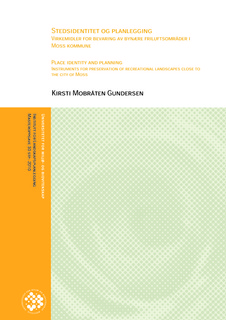| dc.description.abstract | Det har i det siste blitt et økt fokus på bynære friluftsområder. Bakgrunnen for det økte fokuset er blant annet friluftsområdenes betydning for folkehelse og bevaring av biomangfold. Flere og
flere bosetter seg i og i nærheten av byer, og det er et uttalt statlig mål å kunne tilby befolkningen friluftsområder, i dag og i framtiden. Denne masteroppgaven handler om hvordan bynære friluftsområder, nærmere bestemt bymark, bevares til friluftsformål. Først og fremst undersøkes hvordan formelle og uformelle virkemidler fungerer sammen for å bevare to markaområder i Moss kommune; midtre Jeløy og Mossemarka. Moss kommune
opplever befolkningsvekst, og har et visst byggepress på sine friluftsområder. Hva betyr de juridiske virkemidlene i bevaringen? Er det potensial for at mobilisering fra sivilbefolkningen
kan være et virkemiddel for bevaring av bymarkene? Med formelle virkemidler menes først og fremst kommuneplanlegging gjennom plan- og bygningsloven. De uformelle virkemidlene som undersøkes er stedsidentitet og mobilisering fra sivilbefolkningen.
Planlegging gjennom plan- og bygningsloven har svakheter som gjør at en på lengre sikt har behov for andre virkemidler for å holde bymark utbyggingsfri. Den største svakheten er kommunale vedtak som kan erstattes eller oppheves. Stedsidentitet kan være et virkemiddel for bevarig av bymark.
Stedsidentitet handler om stedets betydning og verdi for innbyggerne. I begge caseområdene har stedsidentitet påvirket planleggingen, og planleggingen har påvirket betydningen stedene har som friluftsområder. Tidlige planer som konstaterer viktigheten av bevaringen av områder for friluftsliv, har økt forståelsen for friluftsområdenes status og betydningen de har for befolkningen. Det er bred enighet om bevaring av begge caseområdene. Bevaringen av områder til friluftsformål må ha juridisk forankring, men har ofte behov for hjelp fra sivilbefolkningen. Mobilisering er en metode for sivilbefolkningen å vise at et sted har identitet og av den grunn bør bevares til det formålet det har, og som bidrar til at det har identitet. I Moss ser det ut til at velforeninger er en kanal for mobilisering. Foreningene har autonomi og blir hørt i saker som omhandler friluftsområder. Mobilisering kan derfor være et virkemiddel for bevaring av bymark. Lately, the focus on the urban recreational landscape has increased. The backdrop for this focus is, inter alia, that this particular landscape is important for public health and the preservation of biodiversity. The population in and outside cities increases, and it is a governmental goal to preserve recreational landscapes, also in urban areas. This master thesis examins how the urban recreational landscapes, urban woodlands in particular, are being preserved, and not developed as an expansion of the city.
The concern in this master thesis is mainly how formal and informal instruments are working together to preserve two urban woodlands in Moss municipality; central parts of Jeløy and Mossemarka. Moss municipality is experiencing an increase in its population, and there are some
preassure on the cases. What is the importance of the legal instruments in the preservation? Is mobilization through civil society a possible tool? The formal, or legal, instrument is mainly planning by the planning and building act. The informal means I examine in the thesis are place
identity and mobilization through civil society. In the long term, planning by the planning and building act has got some weaknesses that makes it necessary for other means and instruments to be a part of the preservation of the recreational
landscapes. The most important weakness is the fact that decisions made by the municipality are easily changed or cancelled. Place identity can be a valuable instrument for preservation of urban
woodlands. Place identity is about a place importance to the citizens. The thesis examins the context between place identity and planning, and how the two instruments affect each other. In both cases, place identity has affected planning, and planning has affected the place and its importance as recreational area. The early municipal plans that stated these landscapes importance, has increased the populations understanding of the areas as recreational landscapes, and the population has increased the importance in the municipal planning. A legal basis is needed, but sometimes civil society are helpfull in preserving these urban woodlands.
Mobilization is a method for civil society to express the identity of a place, and for that reason, needs to be preserved. Mobilization can therefore be an effective instrument for preservation of urban woodlands. | en_US |
